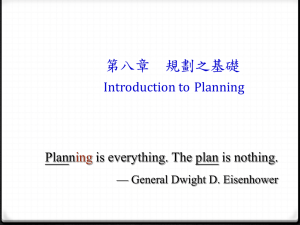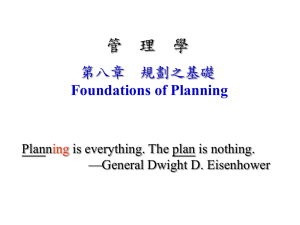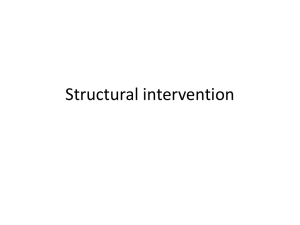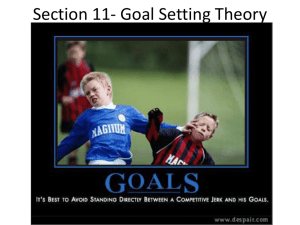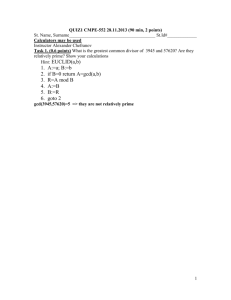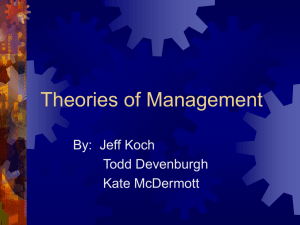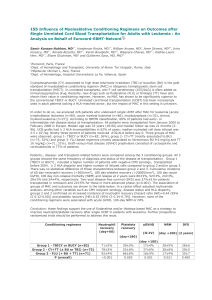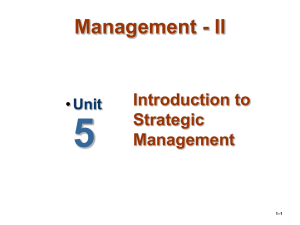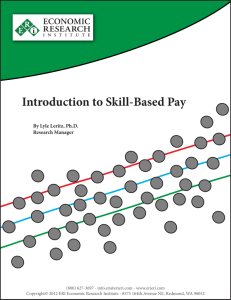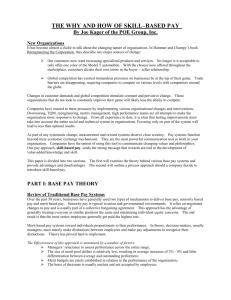chapter 5 - motivation: from concepts to applications
advertisement
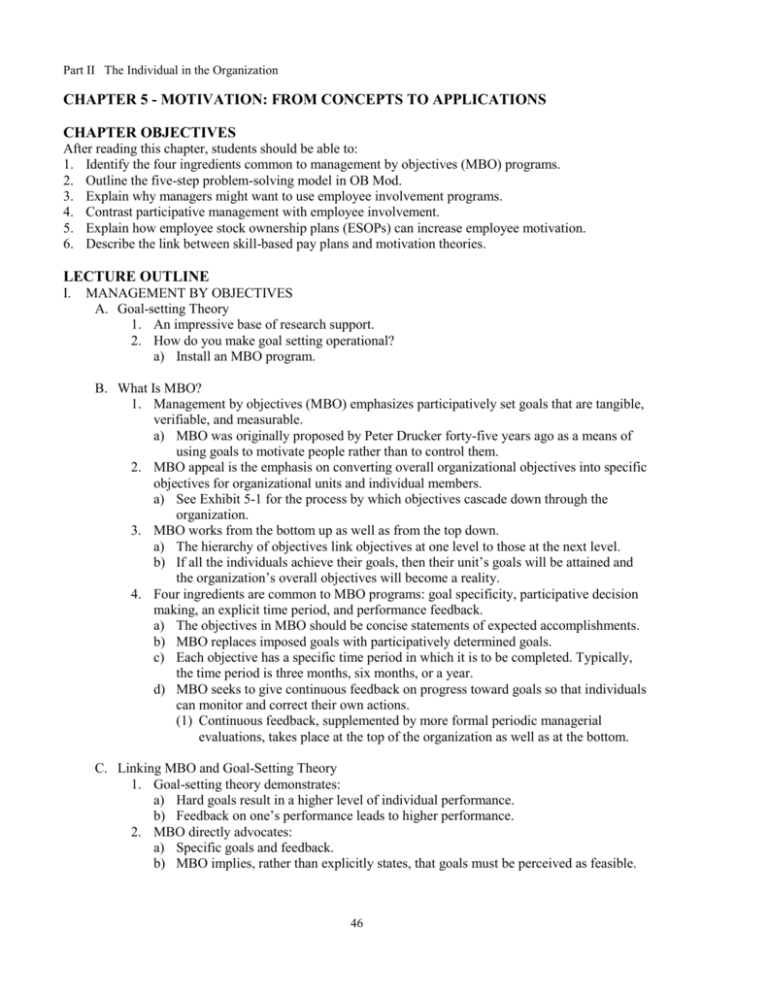
Part II The Individual in the Organization CHAPTER 5 - MOTIVATION: FROM CONCEPTS TO APPLICATIONS CHAPTER OBJECTIVES After reading this chapter, students should be able to: 1. Identify the four ingredients common to management by objectives (MBO) programs. 2. Outline the five-step problem-solving model in OB Mod. 3. Explain why managers might want to use employee involvement programs. 4. Contrast participative management with employee involvement. 5. Explain how employee stock ownership plans (ESOPs) can increase employee motivation. 6. Describe the link between skill-based pay plans and motivation theories. LECTURE OUTLINE I. MANAGEMENT BY OBJECTIVES A. Goal-setting Theory 1. An impressive base of research support. 2. How do you make goal setting operational? a) Install an MBO program. B. What Is MBO? 1. Management by objectives (MBO) emphasizes participatively set goals that are tangible, verifiable, and measurable. a) MBO was originally proposed by Peter Drucker forty-five years ago as a means of using goals to motivate people rather than to control them. 2. MBO appeal is the emphasis on converting overall organizational objectives into specific objectives for organizational units and individual members. a) See Exhibit 5-1 for the process by which objectives cascade down through the organization. 3. MBO works from the bottom up as well as from the top down. a) The hierarchy of objectives link objectives at one level to those at the next level. b) If all the individuals achieve their goals, then their unit’s goals will be attained and the organization’s overall objectives will become a reality. 4. Four ingredients are common to MBO programs: goal specificity, participative decision making, an explicit time period, and performance feedback. a) The objectives in MBO should be concise statements of expected accomplishments. b) MBO replaces imposed goals with participatively determined goals. c) Each objective has a specific time period in which it is to be completed. Typically, the time period is three months, six months, or a year. d) MBO seeks to give continuous feedback on progress toward goals so that individuals can monitor and correct their own actions. (1) Continuous feedback, supplemented by more formal periodic managerial evaluations, takes place at the top of the organization as well as at the bottom. C. Linking MBO and Goal-Setting Theory 1. Goal-setting theory demonstrates: a) Hard goals result in a higher level of individual performance. b) Feedback on one’s performance leads to higher performance. 2. MBO directly advocates: a) Specific goals and feedback. b) MBO implies, rather than explicitly states, that goals must be perceived as feasible. 46 Chapter 5 Motivation: From Concepts to Application c) Consistent with goal setting theory, MBO would be most effective when the goals are difficult enough to require the person to do some stretching. 3. The only area of possible disagreement between MBO and goal-setting theory is related to the issue of participation. a) MBO strongly advocates it. b) Goal-setting theory demonstrates that assigning goals to subordinates frequently works just as well. c) The major benefit to using participation, however, is that is appears to induce individuals to establish more difficult goals. D. MBO in Practice 1. Reviews of studies suggest that it is a popular technique. a) MBO programs are in business, health care, educational, government, and nonprofit organizations. 2. MBO’s popularity should not be construed to mean that it always works. a) There are a number of documented cases in which MBO was implemented but failed to meet management’s expectations. b) The problems rarely lie with MBO’s basic components. c) The causes tend to be unrealistic expectations, lack of top-management commitment, and an inability or unwillingness by management to allocate rewards based on goal accomplishment. II. BEHAVIOR MODIFICATION A. Emery Air Freight Study 1. Occurred almost thirty years ago with freight packers at Emery Air Freight (now part of FedEx) a) Management wanted packers to aggregate shipments into freight containers rather than handle many separate items. b) Packers claimed 90 percent of shipments were put in containers. c) Analysis showed container use rate was only 45 percent. d) In order to encourage employees to use containers, management established a program of feedback and positive reinforcement. e) Container use jumped to more than 90 percent on the first day of the program and held to that level. f) This simple program saved the company millions of dollars. 2. The Emery Air Freight study illustrates the use of organizational behavior modification (OB Mod). B. What Is OB Mod? 1. See Exhibit 5-2. 2. A five-step problem-solving model: a) Identify performance-related behaviors. b) Measure the behaviors. c) Identify behavioral contingencies. d) Develop and implement an intervention strategy. e) Evaluate performance improvement. 3. Identify the behaviors that have a significant impact on the employee’s job performance. a) These are those 5 to 10 percent of behaviors that may account for up to 70 or 80 percent of each employee’s performance. 4. The manager then develops some baseline performance information. a) The number of times the identified behavior is occurring under present conditions. 47 Part II The Individual in the Organization 5. The third step is to perform a functional analysis to identify the behavioral contingencies or consequences of performance. a) This tells the manager which cues emit the behavior and which consequences are currently maintaining it. 6. Now the manager is ready to develop and implement an intervention strategy to strengthen desirable performance behaviors and weaken undesirable behaviors. a) The appropriate strategy will entail changing some element of the performancereward linkage—structure, processes, technology, groups, or the task—with the goal of making high-level performance more rewarding. 7. The final step in OB Mod is to evaluate performance improvement. C. Linking OB Mod and Reinforcement Theory 1. Reinforcement theory relies on positive reinforcement, shaping, and recognizing the impact of different schedules of reinforcement on behavior. 2. OB Mod uses these concepts to provide managers with a powerful/proven means for changing employee behavior. D. OB Mod in Practice 1. OB Mod has been used to improve employee productivity and to reduce errors, absenteeism, tardiness, and accident rates. a) General Electric b) Weyerhauser c) The city of Detroit d) Xerox 2. A general review of OB programs found an average 17 percent improvement in performance. III. EMPLOYEE RECOGNITION PROGRAMS A. The Laura Schendell Example 1. Organizations are increasingly recognizing what Laura Schendell is acknowledging: recognition can be a potent motivator. B. What Are Employee Recognition Programs? 1. Numerous forms 2. The best use multiple sources and recognize both individual and group accomplishments. C. Linking Recognition Programs and Reinforcement Theory 1. A survey of 1,500 employees regarding the most powerful workplace motivator. a) Their response was recognition, recognition, and more recognition. 2. Consistent with reinforcement theory, rewarding a behavior with recognition immediately following that behavior is likely to encourage its repetition. 3. And that recognition can take many forms. a) Personally congratulate an employee in private for a good job. b) Send a handwritten note or an e-mail message. c) Publicly recognize accomplishments. d) And to enhance group cohesiveness and motivation, you can celebrate team successes. D. Employee Recognition Programs in Practice 1. Today’s cost pressures make recognition programs particularly attractive. a) Recognizing an employee’s superior performance often costs little or no money. 48 Chapter 5 Motivation: From Concepts to Application b) A survey of 3,000 employers found that two-thirds use or plan to use special recognition awards. 2. One of the most well-known and widely-used recognition devices is a suggestion system. a) Employees offer suggestions for improving processes or cutting costs and are recognized with small cash awards. 3. The Japanese have been especially effective at making suggestion systems work. a) A typical high-performing Japanese plant in the auto components business generates 47 suggestions per employee a year and pays approximately the equivalent of U.S. $35.00 per suggestion. b) In contrast, a comparable Western factory generates about one suggestion per employee per year but pays out $90.00 per suggestion. IV. EMPLOYEE INVOLVEMENT PROGRAMS A. Example 1. Teams perform many tasks and assume many of the responsibilities once handled by their supervisors. B. What Is Employee Involvement? 1. Employee involvement has become a convenient catchall term to cover a variety of techniques. a) Employee participation or participative management b) Workplace democracy c) Empowerment d) Employee ownership 2. Employee involvement is a participative process that uses the entire capacity of employees and is designed to encourage increased commitment to the organization’s success. a) The underlying logic involves workers in decisions that will affect them and increases their autonomy and control, which will result in higher motivation, greater commitment, more productivity, and more satisfaction. 3. Participation and employee involvement are not synonyms. a) Participation is a more limited term. b) It is a subset within the larger framework of employee involvement. C. Examples of Employee Involvement Programs 1. Three forms of employee involvement: participative management, representative participation, and employee stock ownership plans. 2. Participative Management a) Characteristic of all participative management programs is joint decision making. b) Has been promoted as a panacea for poor morale and low productivity. c) Not always appropriate. For it to work: (1) There must be adequate time to participate. (2) The issues must be relevant to the employees. (3) Employees must have the ability to participate. (4) The organization’s culture must support employee involvement. d) Dozens of studies have been conducted on the participation-performance relationship. (1) Mixed findings. 3. Representative Participation a) Rather than participating directly in decisions, workers are represented by a small group of employees who actually participate. 49 Part II The Individual in the Organization (1) The most widely legislated form of employee involvement around the world. 4. The goal of representative participation is to redistribute power within an organization. 5. The two most common forms that representative participation takes are works councils and board representatives. a) Works councils link employees with management. They are groups of nominated or elected employees who must be consulted when management makes decisions involving personnel. b) Board representatives are employees who sit on a company’s board of directors and represent the interests of the firm’s employees. In some countries, large companies may be legally required to make sure that employee representatives have the same number of board seats as stockholder representatives. 6. The overall influence of representative participation on working employees seems to be minimal. a) Works councils are dominated by management and have little impact on employees or the organization. b) The greatest value of representative participation is symbolic. 7. Employee Stock Ownership Plans (ESOPs) a) Company-established benefit plans in which employees acquire stock as part of their benefits. (1) United Airlines, Publix Supermarkets, Graybar Electric, and Anderson Corporation are four examples of companies that are more than 50 percent owned by employees. b) In the typical ESOP an employee stock ownership trust is created. c) Companies contribute either stock or cash to buy stock for the trust and allocate the stock to employees. d) Employees usually cannot take physical possession of their shares or sell them as long as they’re still employed at the company. e) ESOPs increase employee satisfaction and frequently result in higher performance. D. Linking Employee Involvement Program and Motivation Theories 1. Employee involvement draws on several motivation theories. a) Theory Y is consistent with participative management. b) Theory X aligns with the more traditional autocratic style of managing people. c) Two-factor theory relates to employee involvement programs that provide employees with intrinsic motivation by increasing opportunities for growth, responsibility, and involvement in the work itself. E. Employee Involvement Programs in Practice 1. Germany, France, the Netherlands, and the Scandinavian countries have firmly established the principle of industrial democracy in Europe, and other nations, including Japan and Israel, have traditionally practiced some form of representative participation for decades. 2. Participative management and representative participation were much slower to gain ground in North American organizations. a) Now, employee involvement programs stressing participation are the norm. 3. ESOPs. a) They are becoming a popular employee involvement program-having grown to around 10,000, covering more than 10 million employees. V. VARIABLE-PAY PROGRAMS A. Examples 50 Chapter 5 Motivation: From Concepts to Application 1. Nucor Steel has had an incentive compensation plan in place that pays bonuses of as much as 150 percent of base to employees. 2. Rick Benson, an investment banker with Merrill Lynch, earned $1.4 million in 1998— more than six times his base salary. 3. C. Michael Armstrong, Chairman and CEO of AT&T, saw his annual salary and bonus drop from $4.59 million to $3.26 million in 2000. B. What Are Variable-Pay Programs? 1. Piece-rate plans, wage incentives, profit sharing, bonuses, and gain sharing are all forms of variable-pay programs. 2. Differ from traditional programs in that a person is paid not only for time on the job or seniority but for some individual or organizational measure of performance or both. 3. Variable pay is not an annuity. a) With variable pay, earnings fluctuate with the measure of performance. 4. This fluctuation makes these programs attractive to management. a) Part of an organization’s fixed labor costs become a variable cost. b) In addition, when pay is tied to performance, earnings recognize contribution rather than being a form of entitlement. 5. Four of the more widely used of the variable-pay programs follow. a) Piece-rate wages have been around for nearly a century. (1) Popular as a means for compensating production workers. (2) Workers are paid a fixed sum for each unit of production completed. (3) A system in which an employee gets no base salary and is paid only for what he or she produces is a pure piece-rate plan. (4) Many organizations use a modified piece-rate plan, in which employees earn a base hourly wage plus a piece-rate differential. b) Bonuses can be paid exclusively to executives or to all employees. (1) Increasingly, bonus plans are taking on a larger net within organizations to include lower-ranking employees. c) Profit-sharing plans are organization-wide programs that distribute compensation based on some established formula designed around a company’s profitability. (1) These can be direct cash outlays or, particularly in the case of top managers, allocated as stock options. d) The variable-pay program that has gotten the most attention in recent years is undoubtedly gainsharing. (1) A formula-based group incentive plan. Improvements in group productivity— from one period to another—determine the total amount of money to be allocated. (2) The productivity savings can be split between the company and employees in any number of ways, but 50-50 is pretty typical. (3) Gainsharing is similar to profit sharing, not the same. (a) By focusing on productivity gains rather than on profits, gainsharing rewards specific behaviors that are less influenced by external factors than profits are. (b) Employees in a gainsharing plan can receive incentive awards even when the organization isn’t profitable. 6. Variable-pay programs increase motivation and productivity. a) Gain sharing has been found to improve productivity in most cases and often has a positive impact on employee attitudes. C. Linking Variable-Pay Programs and Expectancy Theory 1. Variable pay is compatible with expectancy theory predictions. 51 Part II The Individual in the Organization 2. Group and organization-wide incentives encourage employees to sublimate personal goals in the best interests of their department or the organization. 3. Group-based performance incentives help build a strong team ethic. D. Variable-Pay Programs in Practice 1. Variable pay is rapidly replacing the annual cost-of-living raise because of: a) its motivational power. b) the cost implications. c) the need to avoid the fixed expense of permanent salary boosts. 2. Pay-for-performance has been important for compensating managers for more than a decade. 3. The new trend has been to expand this practice to nonmanagerial employees. a) Seventy-two percent of all U.S. companies had some form of variable-pay plan for nonexecutives in the year 2000. 4. Gainsharing’s popularity seems to be restricted to large, unionized manufacturing companies. VI. SKILL-BASED PAY PLANS A. What Are Skill-Based Pay Plans? 1. Skill-based pay is an alternative to job-based pay. 2. Skill-based pay (also called competency-based pay) sets pay levels on the basis of how many skills employees have or how many jobs they can do. 3. The appeal of skill-based pay plans is flexibility. a) Filling staffing needs is easier when employee skills are interchangeable. b) It facilitates communication throughout the organization because people gain a better understanding of others’ jobs. c) It lessens dysfunctional “protection of territory” behavior. d) Skill-based pay also helps meet the needs of ambitious employees who confront minimal advancement opportunities. 4. There are downsides of skill-based pay. a) People can “top out” relearning all the skills the program calls for them to learn. b) Skills can also become obsolete. c) Skill-based plans do not address level of performance, only whether someone can perform the skill. B. Linking Skill-Based Pay Plans to Motivation Theories 1. Skill-based pay plans are consistent with several motivation theories. 2. Because they encourage employees to learn, expand their skills, and grow, they are consistent with Maslow’s hierarchy of needs theory. 3. Paying people to expand their skill levels is also consistent with research on the achievement need. a) High achievers have a compelling drive to do things better or more efficiently. 4. There is also a link between reinforcement theory and skill-based pay. a) Skill-based pay encourages employees to develop their flexibility, to continue to learn, to cross train, to be generalists rather than specialists, and to work cooperatively with others in the organization. b) To the degree that management wants employees to demonstrate such behaviors, skill-based pay acts as a reinforcer. 5. Skill-based pay may also have equity implications. a) When employees make their input-outcome comparisons, skills may provide a fairer input criterion for determining pay. 52 Chapter 5 Motivation: From Concepts to Application C. Skill-Based Pay in Practice 1. The overall conclusion of studies is that the use of skill-based pay is expanding and that it generally leads to higher employee performance and satisfaction. VII. IMPLICATIONS FOR MANAGERS 1. Organizations have introduced a number of programs designed to increase employee motivation, productivity, and satisfaction. Importantly, these programs are grounded on basic motivation theories. 2. It is easy to criticize educators and researchers for their focus on building theories. Students and practitioners often consider these theories unrealistic or irrelevant to solving real-life problems. This chapter makes a good rebuttal to those critics. It illustrates how tens of thousands of organizations and millions of managers in countries around the globe are using motivation theories to build practical incentive programs. 3. The six motivation programs we discussed in this chapter are not applicable to every organization or every manager’s needs. But an understanding of these programs will help you design internal systems that can increase employee productivity and satisfaction. SUMMARY 1. Management by objectives (MBO) emphasizes participatively set goals that are tangible, verifiable, and measurable. Its appeal is its ability to convert overall organizational objectives into specific objectives for organizational units and individual members. MBO works from the bottom up as well as from the top down. There are four ingredients common to MBO programs: goal specificity, participative decision making, an explicit time period, and performance feedback. 2. MBO and goal-setting theory are complementary. Goal-setting theory demonstrates that hard goals result in a higher level of individual performance and that feedback on one’s performance leads to higher performance. MBO advocates specific goals and feedback. Consistent with goal setting theory, MBO would be most effective when the goals are difficult enough to require the person to do some stretching. MBO and goal-setting theory differ in terms of participation; MBO strongly advocates it, while goal-setting theory demonstrates that assigning goals to subordinates frequently works just as well. 3. The five-step problem-solving model in OB modification model includes identifying performancerelated behaviors, measuring the behaviors, identifying behavioral contingencies, developing and implementing an intervention strategy, and evaluating performance improvement. It requires the identification of the behaviors that have a significant impact on the employee’s job performance. 4. Employee involvement has become a convenient catchall term to cover a variety of techniques: employee participation, or participative management; workplace democracy; empowerment; and employee ownership. Employee involvement is a participative process that uses the entire capacity of employees and is designed to encourage increased commitment to the organization’s success. The underlying logic involves workers in decisions that will affect them and increase their autonomy and control, which will result in higher motivation, greater commitment, more productivity, and more satisfaction. 5. There are three primary types of employee involvement programs. Participative management involves joint decision making and is often promoted as a panacea for poor morale and low productivity. Representative participation, involves workers being represented by a small group of employees who actually participate. And ESOPs or employee stock ownership plans, company-established benefit plans in which employees acquire stock as part of their benefits. 6. Employee involvement programs are practiced around the world. Germany, France, the Netherlands, and the Scandinavian countries have firmly established the principle of industrial democracy in Europe, and other nations, including Japan and Israel, have traditionally practiced some form of representative participation for decades. 53 Part II The Individual in the Organization 7. ESOPs can increase employee motivation. They tend to increase employee satisfaction and frequently result in higher performance. They are company-established benefit plans in which employees acquire stock as part of their benefits. Employees usually cannot take physical possession of their shares or sell them as long as they’re still employed at the company. 8. Variable-pay programs are another way to motivate employees through piece-rate plans, wage incentives, profit sharing, bonuses, and gain sharing are all forms of variable-pay programs. These differ from traditional programs in that a person is paid not only for time on the job or seniority but for some individual or organizational measure of performance or both. 9. Variable pay is compatible with expectancy theory predictions. The evidence supports the importance of this linkage, especially for operative employees working under piece-rate systems. Group and organization-wide incentives encourage employees to sublimate personal goals in the best interests of their department or the organization. 10. Skill-based pay is an alternative to job-based pay. Its sets pay levels on the basis of how many skills employees have or how many jobs they can do. The appeal of skill-based pay plans is flexibility. There are some downsides however. People can “top out” relearning all the skills the program calls for them to learn, skills can also become obsolete, and so on. 54
